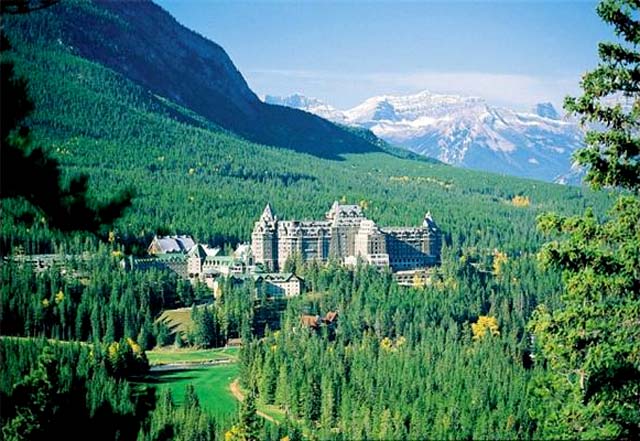|

|


The Banff Springs Hotel presents a remarkable picture for tourists in the Bow Valley - Date/Photographer unknown.
25 May 2013
Banff Springs Hotel Rail Baron's Castle of Dreams Celebrates 125 Years
Banff Alberta - In early 20th-century books, it was described as a "stately pile," and "a most sumptuous affair,"
before being christened the Castle in the Rockies.
When first built in 1888, the Victorian-styled structure looming above the Bow River was an anomaly in Banff, which only had a few log structures, dirt
streets, and mountain men eking out a living as best they could.
One British writer who worked on the railway in 1883 and returned four decades later went so far as to say it didn't seem real.
Morley Roberts recounted seeing the hotel for the first time in his memoir "On the Old Trail: Through British Columbia After Forty
Years".
"The truth is that I could not take beautiful Banff seriously. I dreamed it... on a pine-covered bank or bluff above the crystal foam of the Bow I came to
a gigantic castle. It had no business to be there."
Roberts, who spent years tramping across the West in Canada and the U.S., wrote how he went into the hotel where he caught the eye of another old-timer.
"So when Bill Potts and I shook hands I said, after a look at him, and a look around the hall, "I don't believe it." And people may believe it
or not when I say that he replied at once, "No more do I."
Indeed, the Banff Springs Hotel still seems dreamlike 125 years after it first rose majestically out of the forest, surrounded by towering peaks of the Rocky
Mountains.
But it wasn't a dream which created the hotel, rather a canny decision by the general manager of the CPR to capitalize on the tourism potential of the
West.
"If we cannot export the scenery, we will have to import the tourists," Sir William Cornelius Van Horne is reported to have said. He was responsible
for a series of railway dining halls and hotels being built across the country, including Hotel Vancouver and the Chateau Frontenac in Quebec
City.
In the West, Van Horne instigated construction of Mount Stephen House at Field, Fraser Canyon Hotel, and Glacier House at Rogers Pass.
But Van Horne's grandest vision was reserved for the Banff Springs.
He hired Bruce Price, a New York architect (and father of etiquette author Emily Post), who also designed the Frontenac. Construction began on the $250,000
structure in 1887, but a builder's mistake caused it to face away from the mountains it opened on.
But this wasn't the grand stone castle that stands today at the confluence of the Bow and Spray rivers. The original was a four-storey wooden structure with
250 rooms costing $3.50 a night. The first season saw 1,503 guests. That grew to 22,000 by 1911, leading to a series of renovations and expansions. What was
left of the original chalet burned in 1926, and the new hotel, which resembled both a Scottish castle and a French chateau, opened in 1928.
But right from the start in 1888, tourists from Eastern Canada and the U.S. began pilgrimages on the CPR, bringing Van Horne's railway dream to
life.
Visitors wanted to experience the mountains and the local culture, which included First Nations.
They got their wish each year during Banff Indian Days.
Whyte Museum resources show the annual event got its start in 1894 when spring floods washed away the rails and stranded tourists. The hotel manager asked
local guide Tom Wilson for help entertaining the guests, The guide rode out to the Stoney First Nations reserve near Morley and asked if they would demonstrate
their dancing and riding skills. They settled on a fee and the event was a hit. It carried on until the late 1970s.
Those early pioneering guests, some staying as long as a month, evolved into a sophisticated clientele by the 1930s and 1940s.
Actors, politicians, and dignitaries made the rounds, including Prime Minister William Lyon Mackenzie King, King George VI, and Queen Elizabeth in 1939, Helen
Keller, Bing Crosby, and Ginger Rogers.
"It's Canada's Castle in the Rockies and it has that intrigue," says Dave Moberg, one of the hotel's longest serving employees with 51
years.
"This hotel is not about celebrities or movie stars. It's about our guests, the staff who've worked here and the people who become passionate about the
hotel."
There wasn't much excitement about it in the 1940s, however, when Banff Springs went through a period of neglect amid low tourist traffic. The hotel closed
between 1942 and 1945, freeing up thousands of employees for the war effort, said Deon Klatt, who helps lead the hotel's history tour.
"In the 1950s, it opened in a state of disrepair. It was a rundown summer hotel. There was even talk of tearing it down."
A week long visit by Hollywood's biggest star brought back a touch of that early glamour.
Marilyn Monroe stayed at the hotel in 1953 while filming "River of No Return".
A British man who was her driver at the time returned to the hotel for a visit a few months ago, said Moberg.
"I met this gentleman in the lobby. He was a big tall gentleman with rosy cheeks. He said he used to work here in 1953. I asked what he did and he said he
was Marilyn Monroe's chauffeur."
When Monroe was filming, another movie starring Alan Ladd and Shelley Winters, was also being made nearby. The chauffeur was asked to take the two directors
out on the town one night.
"He said they asked him, "Can you take us to the nearest cat house?" and he, being a naive British student, took them to the
veterinarian."
More Hollywood stars followed in the years after but the hotel struggled to find its footing. Banff Springs began to focus on short-stay tourists, bus, and
rail tours, and an emerging conference trade.
In 1971 Ivor Petrak became general manager and kicked off a period of restoration. "He had the vision to change it from that to a year-round, world-class
alpine ski resort," said Klatt.
But some of the renovations through the years left some strange results. Staffers tell of a lost room that got covered over by the first renovations 100 years
ago. Another reno created an unusual suite on the fourth floor with the bathroom behind the door and the bedroom at the bottom of a wide
staircase.
Other changes include refurbishing the infamous staff annex to create 245 extra rooms in time for the 1988 Olympic Games.
A new manager in the 1990s brought a renewed sense of luxury.
Two rooms that really reflect that sense of glamour are also staff favourites. Klatt loves the Cascade ballroom which hosted big band leader Moxie Whitney and
Fred Astaire. Stepping inside is like a time warp, with the room painted elegant hues, with crystal chandeliers, and rich fabrics.
Mount Stephen Hall is also a nod to the past. Not much has changed in this expansive room where many weddings occur, including those of hockey players and
figure skaters.
"I remember one wedding where they spent over a million. It had full security, a cinematography team, and even a railway line built along the walkway to
hold the cameras," said Klatt, who declined to identify the bride and groom, saying only they weren't celebrities.
Tourism and events have become big business for Banff Springs and a $25-million conference centre was added in 1991. A year later, the hotel was declared a
national historic site. In 1995, the $12-million Solace Spa opened and it became known as a Fairmont property in 1999 when Canadian Pacific Hotels bought
Fairmont Hotels.
Today the hotel boasts 768 guest rooms, a 27-hole golf course, 12 seasonal restaurants, and up to 1,200 employees.
The hotel's newest manager believes it's well-positioned for the next 125 years.
"I have seen a tremendous amount of the world that is overpopulated and overbuilt," said David Roberts, who managed Banff Springs for three years
before being transferred to the Middle East. He's been back now for about six weeks.
"As all of the countries get wealthier and look to find a patch of green grass, they're going to look at the national parks of Canada as a choice that's
even more important."
"The Canadian tourism slogan of moose, mountains, and Mounties hasn't gone away and I think it will never go away."
Michele Jarvie.



Vancouver Island
British Columbia
Canada
|

